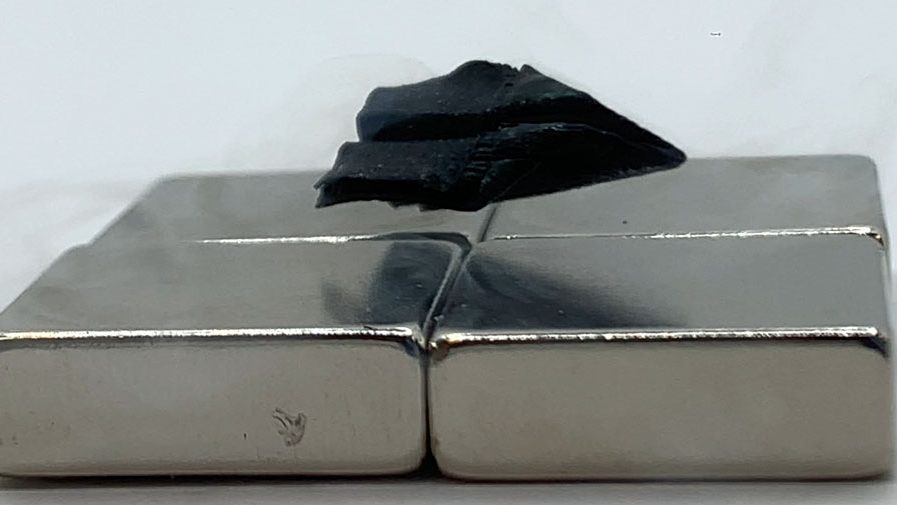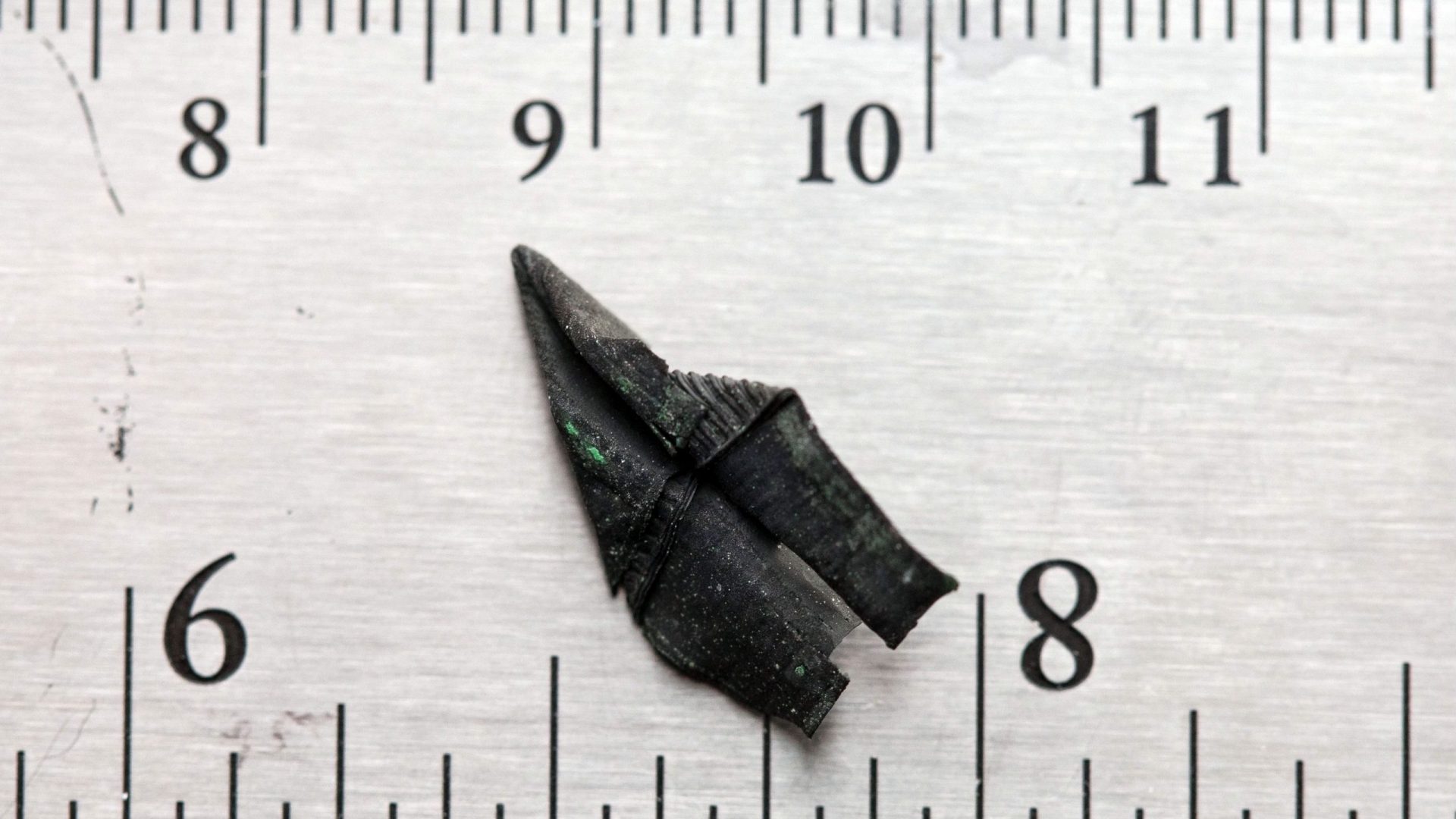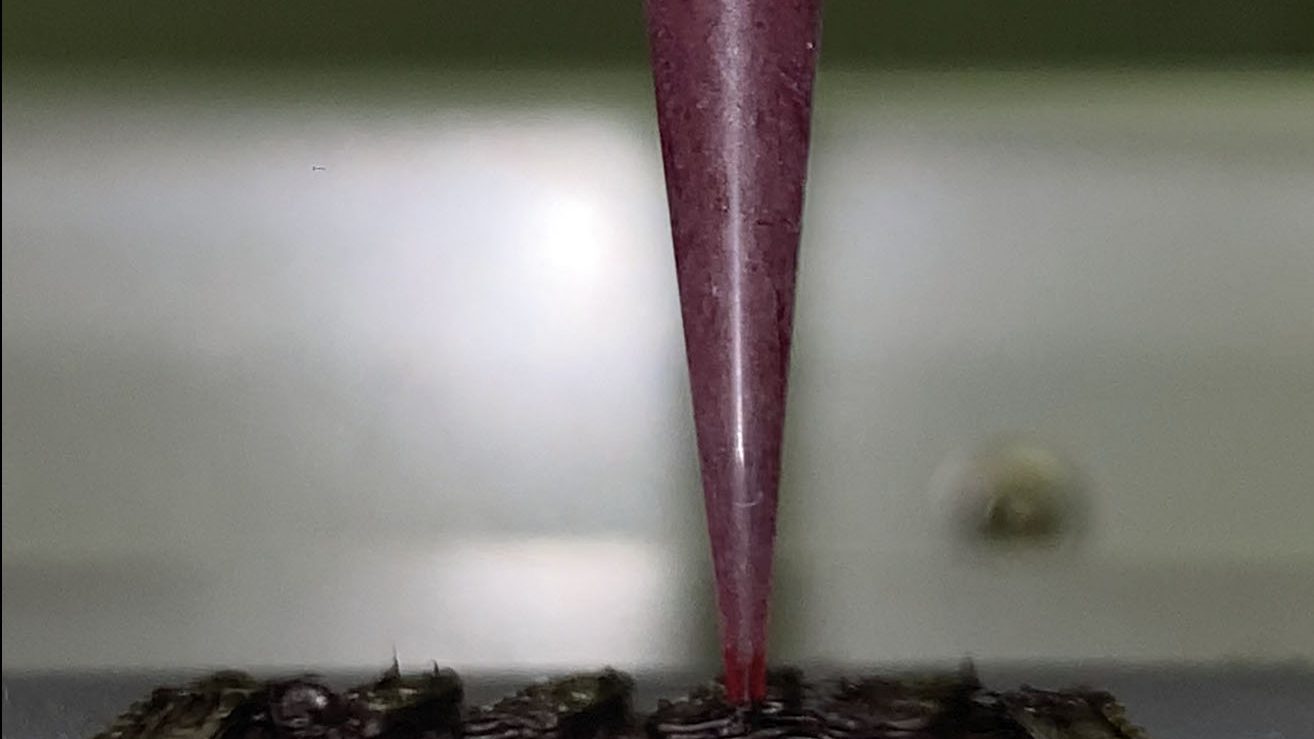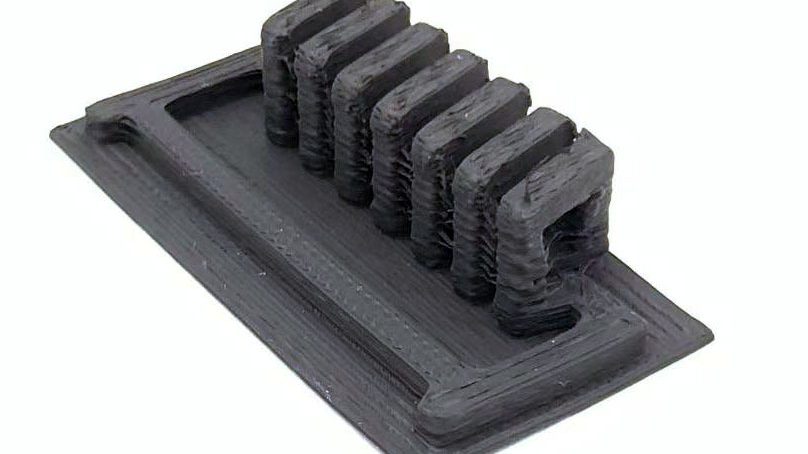Funding from the U.S. Department of Energy’s Fermi National Accelerator Laboratory has enabled researchers at Northwestern University and Fermilab to invent a new process for 3D printing high-temperature superconductors. This method is the first to fabricate 3D-printed ceramic superconductors with a monocrystalline microstructure and is currently awaiting U.S. patent approval.
Their paper was published Feb. 24 in Nature Communications.
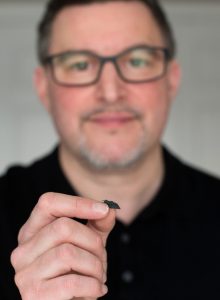
Credit: Melanie Turenne
Superconductors are a special type of material that can conduct electricity with zero resistance — but only at extremely cold temperatures. High-temperature superconductors are unique because they work at temperatures greater than traditional superconductors, making them more practical for applications.
Cristian Boffo, a co-author on the paper, secured funding for the project through Fermilab’s Laboratory Directed Research and Development program. Boffo is project director for the Proton Improvement Plan-II, a project building a state-of-the-art superconducting linear accelerator at Fermilab.
Boffo received LDRD funding to develop advanced magnets called superconducting undulators, aligning with activities planned in Fermilab’s Applied Physics and Superconducting Technology Directorate. One of the project’s aims is to explore new technologies that can revolutionize the design and manufacturing of superconducting undulators through the introduction of high-temperature superconductors and 3D printing. That’s where the Northwestern researchers came in.
“Fermilab wants to make better and better magnet systems that are more efficient and reach higher performance,” said Boffo. “Northwestern provides the experience in 3D printing, and we provide experience in superconductors.”
The quest for high-temperature superconductors
When electricity flows through a material at normal temperatures, there will always be some energy loss due to resistance. Over 100 years ago, scientists discovered the phenomenon of superconductivity: when brought down to temperatures close to absolute zero — minus 460 degrees Fahrenheit (minus 273 degrees Celsius) — materials lose electrical resistance, enabling electricity to move through them extremely efficiently. This requires expensive and hard-to-handle coolants like liquid helium.
In the 1980s, scientists discovered high-temperature superconductors that will operate at a higher — albeit still frigid — critical temperature of minus 321 degrees Fahrenheit (minus 196 degrees Celsius). These are mostly ceramic materials, often copper oxides combined with other metallic oxides. These superconductors can be cooled with liquid nitrogen instead of liquid helium.
“This new technology will enable new magnet designs, leading to higher performances and potentially even allow the production of a new generation of superconducting radio-frequency cavities.”
Cristian Boffo
Fermilab
“Using liquid nitrogen, it’s much less expensive to cool down the structure to where it becomes superconducting,” said David Dunand, a professor of materials science and engineering at Northwestern University who performed the research.
Today, technological uses for superconductivity range from low-loss power generators to electric motors, from medical imaging technology to quick, quiet magnetically levitated trains. But superconductors’ need for extreme cold limits their usefulness, so developing high-temperature superconductors is vital for advancing everyday applications.
And in physics, high-temperature superconductors are especially advantageous because they retain their superconductivity in higher magnetic fields than traditional superconducting materials do.
From polycrystals to monocrystal
To 3D print superconducting ceramics, scientists start with a “precursor powder”: a finely milled mix of chemical compounds. They combine the powder with a binder to create a printable paste, which can then be extruded by a 3D printer to build a structure, layer by layer — like the coil technique of making pottery. The structure is then heated and baked in a furnace, a high-temperature process known as sintering.
The resulting piece has a polycrystalline microstructure, but this is not ideal for creating or trapping a strong magnetic field. A monocrystalline superconductor would have much better properties for potential uses in accelerator physics, but it cannot be made via powder 3D printing.
So Dunand and his graduate student Dingchang Zhang sought to demonstrate, for the first time, a way to combine the superior physics properties of a monocrystalline superconductor with the complex architecture of a 3D-printed polycrystalline structure.
The new paper outlines their successful method. They 3D print a ceramic polycrystalline superconductor using common precursor powder mixture called yttrium barium copper oxide, or YBCO. Once it is sintered, researchers place a single-crystal seed made of a different superconducting material, neodymium barium copper oxide, or NdBCO, on top. They then begin a process called top seeded melt growth: heating the printed structure so it partially melts, filling holes or pores in the 3D-printed microstructure, making it more robust. Researchers then cool the structure very slowly so it re-solidifies with the same crystallographic orientation as the seed. The final piece retains its original 3D-printed shape, now with a stronger monocrystalline structure.
Dunand and Zhang used their method first with a 3D-printed micro-lattice shape, then graduated to more complex shapes. They found they could use a single seed to fabricate superconducting pieces up to 10 centimeters in diameter. They even used their method to 3D print a foil of superconducting material that Zhang folded into the shape of a tiny paper airplane, demonstrating that 3D-printed superconductors can be formed into complex shapes with sharp corners.
In the future, they hope to investigate multi-seed methods — different from the polycrystal method — in which they hope to produce larger pieces by using many separate single-crystal seeds.
“If we want to use it for accelerators, we need to print larger parts,” said Zhang, who completed his PhD at Northwestern in August 2024. “If we want to get bigger parts, how will we place the seeds? Whether that will have other problems, we don’t know.”
Dunand said their method “made a huge step forward” by showing it is possible to create monocrystal superconductors with complex shapes. They hope it also inspires further research into 3D printing monocrystal ceramics.
“I think it’s highly, highly scalable,” said Dunand. If they could do it in their lab at Northwestern, Dunand said he thinks it can be replicated in many other settings.
“This new technology will enable new magnet designs, leading to higher performances and potentially even allow the production of a new generation of superconducting radio-frequency cavities,” said Boffo. “I think that this was a very successful collaboration.”
Fermi National Accelerator Laboratory is America’s premier national laboratory for particle physics and accelerator research. Fermi Forward Discovery Group manages Fermilab for the U.S. Department of Energy Office of Science. Visit Fermilab’s website at www.fnal.gov and follow us on social media.
Fermi National Acceleratory Laboratory senior scientists Peter Garbincius and Robert Zwaska have been elected Fellows of the American Association for the Advancement of Science, one of the world’s largest and most prestigious scientific societies. This honor recognized their significant contributions to particle physics and accelerator technology.
Garbincius was named an AAAS Fellow for his “distinguished contributions to particle physics, both as a researcher and manager, and for leadership in outreach programs.” Zwaska was honored for his “distinguished contributions to high-energy accelerator technology, especially high-power targetry.”
Each year, the AAAS Council elects new fellows, celebrating individuals in the science community who made scientifically or socially distinguished efforts to advance science and its applications. In addition to being a professional society, AAAS publishes the influential Science journals.
Peter Garbincius
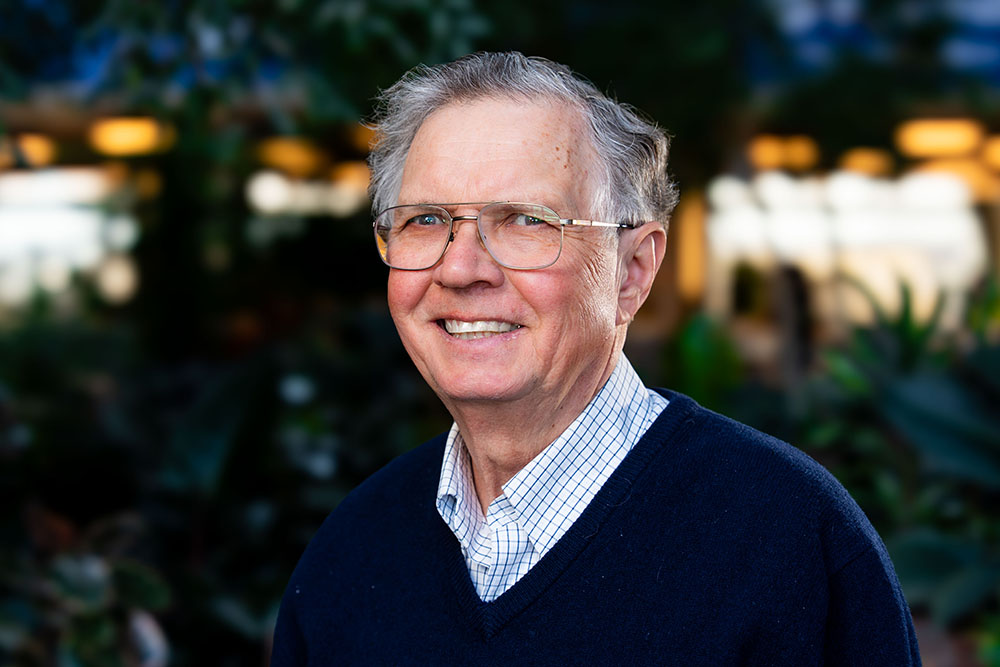
Fermilab scientist emeritus Peter Garbincius worked as a researcher and leader at the laboratory from 1976 to 2020. Throughout his career, he collaborated on particle physics experiments with fixed-target hadron and photon beams, and in proton-antiproton collisions. The experiments focused on the production, decay and properties of elementary particles containing light, charm and bottom quarks, as well as exotic four-quark mesons.
Garbincius held various leadership roles across Fermilab’s Research Division, Accelerator Division and Directorate. He also made a lasting impact through scientific outreach, leading the Ask-a-Scientist program, which provided visitors to Fermilab with information about the lab’s groundbreaking research. The program offered informal lectures, laboratory tours and one-on-one discussions with subject matter experts.
“This award doesn’t just celebrate my achievements, it also belongs to the entire Fermilab family,” said Garbincius. “I’m thankful to everyone with whom I worked, including my mentors, colleagues, collaborators, as well as the Fermilab support staff and the users and affiliates community.”
Robert Zwaska

Robert Zwaska, senior scientist and division director for Fermilab’s Accelerator Complex Technology Division, first came to Fermilab in 2000 for research during his graduate studies at the University of Texas at Austin. As a Fermilab user, he participated in MINOS, an experiment designed to study neutrino oscillations, and the Neutrinos at the Main Injector beamline project, where he worked on muon detectors and synchronization between accelerators that enabled the NuMI beam. Zwaska was hired by Fermilab in 2005.
In 2011, Zwaska worked on the Proton Improvement Plan, which significantly upgraded Fermilab’s booster ring — improving both its efficiency and reliability to support major experiments such as NOvA and Muon g-2.
Alongside others, Zwaska founded the Target Systems Department in 2015, which focuses on the development and improvement of particle accelerator target systems. Target systems are the beamline devices that convert high-energy protons into subatomic particles for study.
He is currently directing the Accelerator Complex Technology Division, which develops and maintains the accelerator systems at Fermilab Accelerator Complex. Zwaska’s team supports major projects, such as Proton Improvement Plan-II, the Long Baseline Neutrino Facility and the Accelerator Controls Operations Research Network, or ACORN.
Throughout his career, Zwaska has contributed to scientific outreach and education efforts, teaching for the United States Particle Accelerator School program and participating in the Ask-a-Scientist program.
“I’d like to thank my colleagues for, in their discretionary time, nominating me,” said Zwaska. “It’s gratifying that this fellowship is the result of people in this community taking time out of their day.”
Fermi National Accelerator Laboratory is America’s premier national laboratory for particle physics and accelerator research. Fermi Forward Discovery Group manages Fermilab for the U.S. Department of Energy Office of Science. Visit Fermilab’s website at www.fnal.gov and follow us on social media.
At the Department of Energy’s Fermi National Accelerator Laboratory, where groundbreaking particle physics research meets the pioneering spirit of the American prairie, a beloved spring tradition continues. Today, two baby bison arrived, marking the beginning of calving season at the laboratory.
The two calves were born on April 21, healthy and strong, joining Fermilab’s storied herd that has been a part of the lab since 1969. Cleo Garcia, Fermilab’s herdsman, estimates that around 20 calves will be born this season.

“Our herd is doing well,” Garcia said. “Each year, we monitor the cows closely to estimate how many calves we’ll have. It’s always exciting to see the first birth of the season.”
The herd currently consists of 23 cows, two bulls, and three yearlings born in 2024. Fermilab rotates its bulls every five to seven years to maintain genetic diversity, ensuring that the herd remains close to 100% pure American bison. Genetic testing in 2015 confirmed that the herd contains little to no cattle genes — a significant achievement.

When bison calves are born, they sport a distinctive cinnamon-colored coat, which darkens to brown as they grow. At birth, they weigh between 40 and 70 pounds, but by six months, they can reach 300 to 350 pounds. Despite their rapid growth, the young bison remain close to their protective mothers, especially in the first few weeks.
“One of the most exciting moments is when a calf takes its first steps,” Garcia said. “Sometimes, within just a few minutes of being born, they’re already up and walking around — it’s incredible to see.”
Calving season generally continues through June, however last year a calf was born in September. Visitors are encouraged to stop by to see the newest members of the herd. Fermilab’s outdoor public areas are open daily from dawn to dusk, offering a chance to witness these iconic animals in their natural habitat. Visitors 18 and older must present REAL ID-compliant identification to enter the laboratory grounds. To accommodate people unable to visit in person, the Fermilab bison cam provides a virtual view of the herd from anywhere in the world.
“Seeing new life arrive on the prairie is one of the best parts of the year,” Garcia said.

Visit Fermilab’s Hours and public access webpage for information and requirements for visiting the lab, and come celebrate the arrival of spring along with Fermilab’s newest additions.
Fermi National Accelerator Laboratory is supported by the Office of Science of the U.S. Department of Energy. The Office of Science is the single largest supporter of basic research in the physical sciences in the United States and is working to address some of the most pressing challenges of our time. For more information, please visit science.energy.gov.
The U.S. Department of Energy’s Fermi National Accelerator Laboratory has selected Cristian Boffo to be the new project director of the Proton Improvement Plan-II project.
Formerly the PIP-II project manager, Boffo will now lead the billion-dollar enhancement to the Fermilab accelerator complex. The PIP-II project is constructing a 215-meter-long state-of-the-art superconducting linear accelerator that will drive a broad physics research program and provide powerful, high-intensity proton beams for the Deep Underground Neutrino Experiment — an international collaboration hosted by Fermilab in Batavia, Illinois and Lead, South Dakota.

“Cristian is an accomplished engineer and proven leader,” said Young-Kee Kim, interim director of the U.S. Department of Energy’s Fermi National Accelerator Laboratory, where PIP-II is located. “He has long been an essential member of the PIP-II leadership team, and we are thrilled Cristian has agreed to step into the project director role. The lab is privileged to be able to tap his expertise and familiarity with the project and collaboration.”
Boffo first joined Fermilab as part of the Linear Collider group after earning his master’s in mechanical engineering in 1999. He later moved to Europe and worked in industry, where he advanced as a project manager and business developer for superconducting systems. Boffo returned to Fermilab in 2019, assuming multiple roles within the PIP-II team and continuing his technical efforts to advance the development of superconducting magnet systems.
“When I joined PIP-II six years ago, I never could have anticipated reaching this position and having the privilege of leading such a talented team,” said Boffo. “This remarkable group possesses incredible energy, and I am confident that, together, we can deliver PIP-II to the laboratory and usher in a new era for Fermilab.”
The PIP-II project is currently advancing through many exciting phases. On site at Fermilab, the Linac Complex building is nearly finished with construction, the newly arrived coldbox cryogenic system is being installed, and upgrades to Fermilab’s Booster and Main Injector are progressing well.
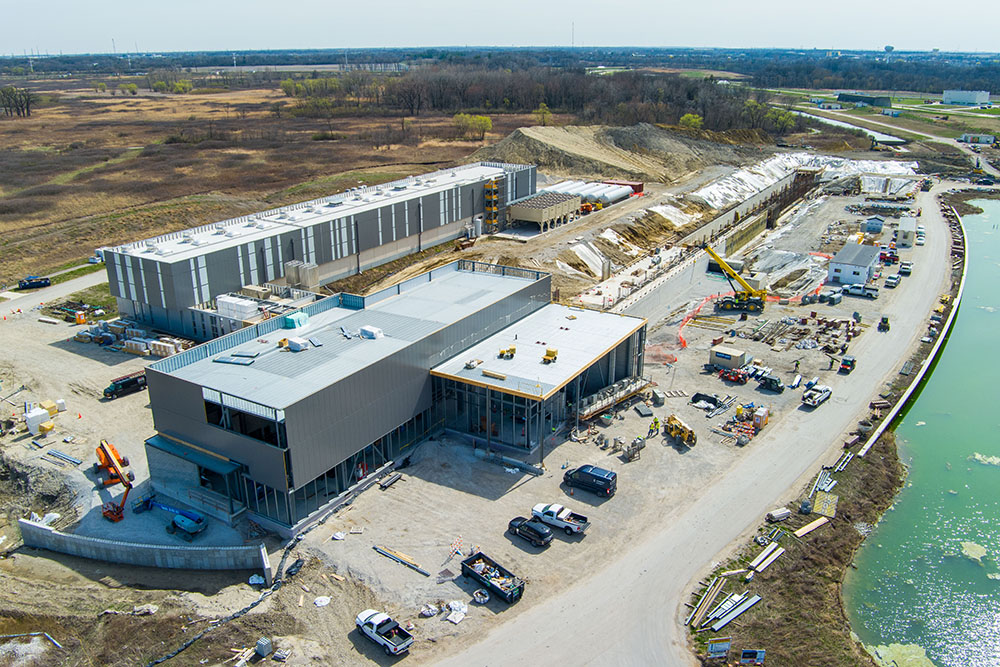
At Fermilab and collaborating institutions around the world, cryomodules for the accelerator are in production, with some to begin assembly this summer. PIP-II is the first particle accelerator built in the United States with significant contributions from international partners. Institutions in France, India, Italy, Poland, the U.K. and the U.S. are bringing together their expertise and capabilities in superconducting radio frequency and associated technologies to construct this state-of-the-art facility.
Fermi National Accelerator Laboratory is America’s premier national laboratory for particle physics and accelerator research. Fermi Forward Discovery Group manages Fermilab for the U.S. Department of Energy Office of Science. Visit Fermilab’s website at www.fnal.gov and follow us on social media.
This press release was originally published by CERN to announce that the ALICE, ATLAS, CMS and LHCb collaborations won the 2025 Breakthrough Prize in Fundamental Physics by the Breakthrough Prize Foundation.
The United States is the largest participating country in the CMS collaboration. US CMS, hosted by the Department of Energy’s Fermi National Accelerator Laboratory, comprises about a third of the CMS collaboration and, outside of CERN, Fermilab is the largest member institution on CMS. Fermilab Distinguished Scientists Joel Butler and Patricia McBride were co-spokespeople for the CMS collaboration for a period during the time recognized by the Breakthrough prize.
This award honors the precise measurements achieved by the CMS collaboration on the Higgs boson since its discovery in 2012. The award also recognizes the collaboration’s exploration of the electroweak scale and beyond, matter/antimatter asymmetry, and studying the dense state of matter that prevailed in the early universe.
“We were delighted to receive this award because it recognizes the work the entire collaboration has been doing since the Higgs boson discovery,” said McBride, who accepted the award on behalf of CMS. McBride served as CMS co-spokesperson from 2022-2024 and held this role when the prize decision was made. “We’ve learned so much about the Higgs boson and how it interacts with all the fundamental particles.”
CMS is an international collaboration with members from 240 institutes across more than 50 countries.
This weekend, the ALICE, ATLAS, CMS and LHCb collaborations at the Large Hadron Collider at CERN were honoured with the Breakthrough Prize in Fundamental Physics by the Breakthrough Prize Foundation. The prize is awarded to the four collaborations, which unite thousands of researchers from more than 70 countries, and concerns the papers authored based on LHC Run-2 data up to July 2024. It was received by the spokespersons who led the collaborations during that time.
The prize was awarded to the collaborations for their “detailed measurements of Higgs boson properties confirming the symmetry-breaking mechanism of mass generation, the discovery of new strongly interacting particles, the study of rare processes and matter-antimatter asymmetry, and the exploration of nature at the shortest distances and most extreme conditions at CERN’s Large Hadron Collider”.
“I am extremely proud to see the extraordinary accomplishments of the LHC collaborations honoured with this prestigious Prize,” said Fabiola Gianotti, Director-General of CERN. “It is a beautiful recognition of the collective efforts, dedication, competence and hard work of thousands of people from all over the world who contribute daily to pushing the boundaries of human knowledge.”
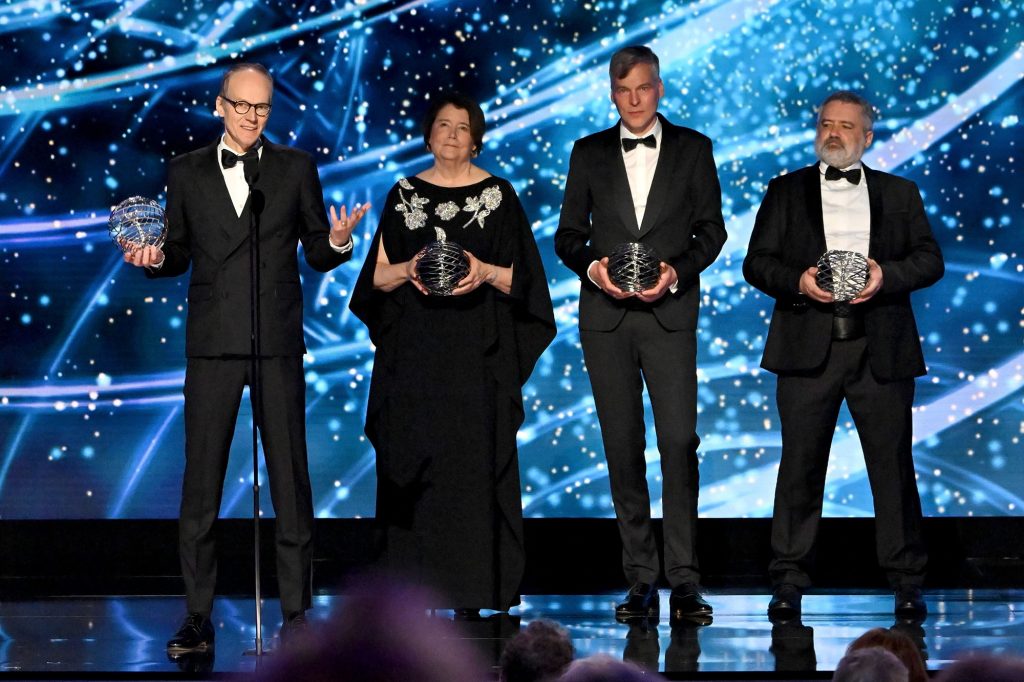
Following consultation with the experiments’ management teams, the Breakthrough Prize Foundation will donate the $3 million Prize to the CERN & Society Foundation. The Prize money will be used to offer grants for doctoral students from the collaborations’ member institutes to spend research time at CERN, giving them experience in working at the forefront of science and new expertise to bring back to their home countries and regions.
ATLAS and CMS are general-purpose experiments, which pursue the full programme of exploration offered by the LHC’s high-energy and high-intensity proton and ion beams. They jointly announced the discovery of the Higgs boson in 2012 and continue to investigate its properties.
“This prize recognises the collective vision and monumental effort of thousands of ATLAS collaborators worldwide”, says ATLAS spokesperson Stephane Willocq. “Their talent and dedication, and the support of our public funding agencies, enabled the scientific breakthroughs that are being celebrated today. These results have transformed our understanding of the Universe at the most fundamental level.”
“CMS is deeply honoured to receive this prestigious prize,” said CMS spokesperson Gautier Hamel de Monchenault. “Through continuous innovation in exploiting the data from the Large Hadron Collider over the past fifteen years, the CMS collaboration is conducting a thorough characterisation of the Higgs boson, exploring the electroweak scale and beyond and probing the hot, dense state of nuclear matter that prevailed in the early Universe.”
ALICE studies quark-gluon plasma, a state of extremely hot and dense matter that existed in the first microseconds after the Big Bang, while LHCb explores minute differences between matter and antimatter, violation of fundamental symmetries and the complex spectra of composite particles (“hadrons”) made of heavy and light quarks, among other things.
“The ALICE collaboration is honoured to receive the Breakthrough Prize for the investigation of the properties of the hottest and densest matter available in a laboratory, quark-gluon plasma”, says ALICE spokesperson Marco Van Leeuwen. “The new grants funded through this prize will contribute to training the next generation of ALICE scientists.”
“The award of the 2025 Breakthrough Prize is a great honour for the LHCb collaboration. It underlines the importance of the many measurements made by the LHCb experiment in flavour physics and spectroscopy through the exploration of subtle differences between matter and antimatter and the discovery of several new heavy quark hadrons”, says LHCb spokesperson Vincenzo Vagnoni.
By performing these extraordinarily precise and delicate tests, the LHC experiments have pushed the boundaries of knowledge of fundamental physics to unprecedented limits. They will continue to do so with the upcoming upgrade of the Large Hadron Collider, the High-Luminosity LHC, which aims to ramp up the performance of the LHC, starting in 2030, in order to increase the potential for discoveries.
Fermi National Accelerator Laboratory is America’s premier national laboratory for particle physics and accelerator research. Fermi Forward Discovery Group manages Fermilab for the U.S. Department of Energy Office of Science. Visit Fermilab’s website at www.fnal.gov and follow us on social media.
DOE’s Office of Science is the single largest supporter of basic research in the physical sciences in the United States, and is working to address some of the most pressing challenges of our time. For more information, please visit energy.gov/science.
When tackling a complex project, the tools and equipment researchers use can greatly impact the results. That is the basis of the Department of Energy’s Office of Science Innovative and Novel Computational Impact on Theory and Experiment program, known as INCITE. This year the program awarded 81 computational science projects access to leadership-class supercomputers at DOE’s Argonne and Oak Ridge National Laboratories to accelerate discovery and innovation.
One of the largest recipients of an INCITE award this year is a project led by Andreas Kronfeld at Fermi National Accelerator Laboratory. The project, called Advances in Quark and Lepton Flavor Physics with Lattice QCD, was the largest particle physics project among the recipients this year. The award will allow the project’s researchers, who are working at several national labs and U.S. universities, to use the Aurora and Frontier supercomputers to continue the study of the behavior and interactions of subatomic particles against the Standard Model of Particle Physics.
“We are honored to have received the renewal of INCITE and the largest award in particle physics,” said Andreas Kronfeld, Fermilab researcher and the project’s principal investigator. “This will allow us to continue conducting large-scale numerical calculations on world-class supercomputers that will impact experiments at Fermilab, CERN, KEK and other accelerator laboratories.”
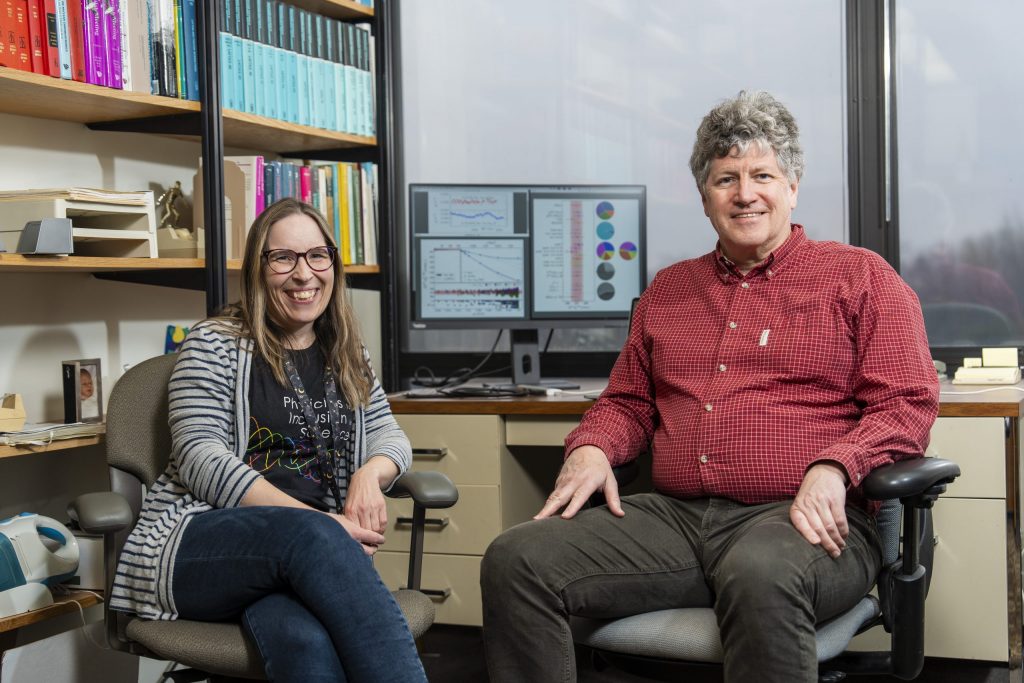
The Advances in Quark and Lepton Flavor Physics with Lattice QCD project uses numerical simulations based on the lattice gauge theory formulation of quantum to address fundamental questions in elementary particle physics: the hadronic vacuum polarization contribution to the anomalous magnetic moment of the muon, also known as muon g-2, semileptonic decays of the heavy bottom and charm quarks, and CP violation. Precise calculations from supercomputers are needed to compare theoretical calculations with experimental measurements.
“It is especially exciting that this year we will be able to finish a calculation of the muon g-2 after several years of key support from INCITE,” said Ruth Van de Water, project member and Fermilab scientist. “Recent developments, including results from the Fermilab Muon g-2 experiment make this topic incredibly timely!”
Being awarded time to use supercomputers is valuable to complex projects because their enormous capability enables researchers to tackle complex systems with more precision and efficiency than with general-purpose computers.
The INCITE program is the primary means by which the facilities fulfill their mission to advance open science by providing the scientific community with access to their powerful supercomputing resources. It is jointly managed by the Argonne Leadership Computing Facility and the Oak Ridge Leadership Computing Facility.
Fermi National Accelerator Laboratory is supported by the Office of Science of the U.S. Department of Energy. The Office of Science is the single largest supporter of basic research in the physical sciences in the United States and is working to address some of the most pressing challenges of our time. For more information, please visit science.energy.gov.

